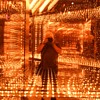Posted 11 years ago
 cogito
cogito
(124 items)
Well, this piece is a partial mystery. The flowing orchid and repetitive gui bronze overlay, which at one point in the past was gilded, is the handiwork of Marcel Bing, the jeweler and metalwork artist son of Siegfried Bing (of L'Art Nouveau fame). Bing's metal mounts are out on the market, but often not recognized because of a rarity of attributed designs and the fact that his mounts are never signed. The quality of the mount speaks for itself with minute detail that only one can appreciate upon close inspection (i.e., faux woodgrain around bottom mount rim; orchid flower texture details suggesting the delicate wrinkling of the petals; etc.), but without a known comparison one would not be able to attribute the mount to a designer. Solid attribution of this piece comes from an interesting chain of features shared between three pieces; (1) a pictured piece in Duncan's "Paris Salons," (2) a linking piece (crystal decanter set) sharing a critical metalwork design with the pictured Duncan piece and the distinctive linking, repetitive gui pattern seen around the rim of the (3) third piece above. In coin collecting (one of my prior passions) this chain of features is termed a die linkage and would not be inappropriate to apply to decorative metalwork.
What is a mystery, however, is the glass type and manufacture of the art glass used as the background for the Bing mount. I've never seen anything quite like it, but hopefully some can offer ideas. What we do know is the following:
1.) the mount and piece are reasonably attributed to a production period between 1902 and 1904.
2.) the vase has a good probability of being retailed at L'Art Nouveau given the solid linkage to pieces in Duncan's Paris Salons showing various art glass and ceramic mounted pieces.
N.B., the glass and ceramics shown in Duncan appear to be a mixture of matte single color art glass, marbled glass and various Art Nouveau style gres ceramics, none of which are readily recognized by me but the matte pieces could be Loetz.
The glass itself has an amethyst colored base, but within it are splashes of other colored glass giving a sparse confetti glass look. From the inside of the vase one can easily see the deep purple ground, but from the outside the vase is deceptively iridescent blue and green with nice surface features showing the colored glass inclusions. Minute bubbles throughout the glass, but none on the surface. The bottom does not have a pontil, indicating that it was mold blown from the top. The bottom, however, has been finely plained smooth with wear consistent to it being done at the time of manufacture.
Thoughts on the glass? I'd love to solve this one.
---------------
Marcel Bing (Paris, 1875 - 1920). Trained at the Ecole du Louvre. He was best known for his sublime Art Nouveau style jewelry, which was retailed through various dealers, but his longest designer relationship was with his father, Siegfried Bing. Marcel contributed and executed numerous metalwork designs for L’Art Nouveau, the famed Paris gallery founded by his father, generally bronze, gold and silver overlay for art glass and ceramics executed by other artists favored by the gallery (e.g., Dalpayrat, Baudin, Tiffany, etc.). Photographed examples of Marcel's metalwork for L'Art Nouveau are rare, but Alastair Duncan reproduces a page of the art glass and ceramic overlay metalworks in his 1998 "The Paris Salons (1895-1914): Objets D'Art & Metalware" attributed to a production period between 1902-04 It was this Vol. 5 Paris Salons page (pg. 94) that provided the critical chain of clues that allowed the piece above to be solidly attributed to Marcel's metalwork studio.
After his father’s death, Marcel succeeded him in the Japanese art trade, and he was charged with distributing much of the remaining stock of art pieces from L'Art Nouveau to various museum collections of the period.






















































This may be the first time I've seen someone reference Duncan's "Paris Salons" book. I have it, but haven't found it to be a useful reference, glad you were able to put it to use.
Hi, Alfredo. I thought about Bacillus, but the pieces I've seen have had a textured surface where there is a different smooth surface on the "bacilli" relative to the iridescent background. But, you're right, Bacillus is about as close as I could come in terms of shared decor features in my own research.
Why not a Tiffany glass piece??
Oz, you read my mind!
Another stunner C..I'm drooling again
Most beautiful!...:-)
Oz, from your mouth to god's ears!
very beatiful and interesting
So very beautiful. Hope you solve it.